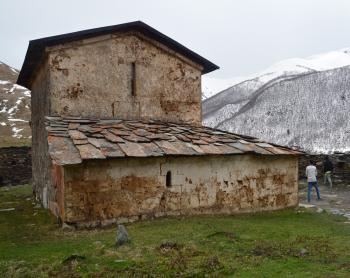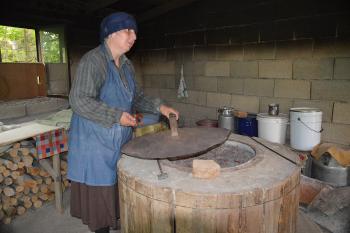Impressive sights abound on a private tour of Georgia
This article appears on page 40 of the December 2017 issue.
We chose to visit the country of Georgia for its historic religious sites, its culture, its cuisine and its gorgeous scenery, and our 8-day stay in May 2017 did not disappoint.
Though this small, sparsely populated country has become, economically, much poorer since its separation from the Soviet Union in 1991, Georgia is still a popular vacation destination for Russians, who love the food and wine, and it has a number of UNESCO World Heritage Sites.
Getting settled
Our long, overnight international flight arrived in Tbilisi at 3:30 a.m., and we went directly to our city-center hotel for a rest. We had booked the 3-star Hotel Voyager through Booking.com for $80 per night. It was new and clean, with 5-star service — a real bargain.
Tbilisi, set in a deep valley of the Kura (Mtkvari) River, has winding, narrow streets lined with balconied houses interspersed with cafés and old churches, all overlooked by the 17th-century Narikala Fortress. After some sleep, we strolled the streets as long as our jet-lagged bodies could manage, walking over the glass Bridge of Peace and peeking inside the Armenian Cathedral of St. George.
We had an early dinner at a Georgian restaurant where costumed, traditional dancers provided entertainment.
In the morning, Maria Romanova, our young Russian driver and guide, met us at the hotel. Though we had considered a self-drive tour, after witnessing the poor road conditions and the erratic driving habits of some of the locals, we were glad we had chosen to hire Maria to be our driver and guide for the seven days. It’s a long distance east to west, and with the terrible road conditions, distances are measured in time rather than kilometers.
Another issue was the difficulty of finding guest houses or small hotels online, especially in the more remote areas, so Maria arranged our accommodations outside of Tbilisi, as well.
We paid $1,500, which included lodgings, all breakfasts, a few dinners, entrance fees and petrol. Maria was very knowledgeable and also used her iPhone to supplement her commentary with other important information.
Impressive sights
Our first stop was a UNESCO World Heritage Site, Jvari Monastery, which was built in the 6th century just outside of Mtskheta. The ascent to the monastery was quite steep, but it offered spectacular views.
As with most historic sites we visited in Georgia, safety precautions seemed to have not been considered. Good mobility and quite a bit of stamina were required at most places, including our next stop, Uplistsikhe, an ancient rock-hewn complex just east of Gori. The caves and structures there date from the Early Iron Age to the Late Middle Ages.
The last site for the day, Bagrati Cathedral & Gelati Monastery near Kutaisi, also housed an academy for scientists, theologians and philosophers. The monastery was well preserved and contained wonderful mosaics and frescoes — a fitting finale to a fabulous first day.
We overnighted at Hotel Ponte in Kutaisi (which can be booked on Booking.com for around $50 a day, including breakfast). The hotel was modern and clean.
Spectacular outdoor scenery and some hiking were on the next day’s itinerary. Just outside of Kutaisi is Okatse Canyon, and Maria skillfully drove us through the area on a very difficult, rocky road. A metal bridge and walkway that ended in an observation deck 141 meters (463 feet) high provided a fabulous view of the canyon.
Getting down to the walkway and, especially, back up required good mobility and stamina.
In the same area were two beautiful waterfalls, one almost 200 feet high.
Mestia
We spent the next two nights in Mestia at Nino Ratiani’s Guesthouse. Our new, all-wood room was clean and spacious.
All of the guest houses we stayed in had private bathrooms with showers, so accommodations were more than adequate for us. The family-style dinners were always an enjoyable cultural experience.
Mestia is located in the Caucasus Mountains in the Svaneti region, known for its snowcapped peaks and deep gorges. The medieval villages of upper Svaneti were dotted with picturesque koshki, defensive stone towers. It was a very beautiful area, steeped in history.
On our second day there, we took a brief ride on the Hatsvali cable car, which took us into the mountains for a cold, snowy view. Then we drove to Ushguli, a community of four villages at the head of the Enguri Gorge. At 7,190 feet, it is the highest village in Europe, with only 200 year-long residents.
The drive to Ushguli was challenging, but the postcard scenery all along the way made it well worth the effort.
Bread and wine
The following day we drove to Kualiti Village to visit a third-generation family winery.
The wine is produced in qvevris, fired clay pots that are buried in the ground, as it has been for 8,000 years. The crushed grapes, stems and skins ferment in the qvevris, and the process, itself, is included on UNESCO’s Intangible Cultural Heritage of Humanity list.
The winery owner was very proud of his wine and his heritage, and he and his mother, wife and son were all very friendly.
To take us to Kazbegi (Stepantsminda), we hired a local driver familiar with the scary, treacherous drive there. The narrow, uphill road, with a drop-off of several hundred feet, had no guardrails.
We overnighted at Kazbegi Guest House Mari. It was very small, with only two rooms, and it was not listed online. The owner served us a traditional dinner, and it was another marvelous interaction with someone local.
One of our favorite interactions on this trip was with a woman in the Kazbegi region. She had a roadside toné oven (like a tandoor) that she used to make shotis puri (a Georgian bread). She explained that her husband, an engineer, was unemployed, so the 125 loaves of bread she made daily and sold on the roadside provided their only income.
Making the bread was a hot and somewhat dangerous process. She had a very hard life but somehow seemed to find joy in her breadmaking.
Our next stop was Bodbe Monastery, in a beautiful setting overlooking the Alazani Valley. Originally built in the 9th century, it is now a nunnery. The mosaics and murals inside were remarkable, and the grounds and gardens were impeccably manicured.
Georgian cuisine
We returned to Tbilisi the following day, arriving mid-afternoon for some much-needed rest at Hotel Voyager. We had an early dinner at a small restaurant, enjoying some simple, traditional food.
The Georgian cuisine was very hearty. One of our favorites was nazuki, a bread that was available only in the town of Surami, in western Georgia. It had fragrant clove, cinnamon and raisins.
We also became fond of khinkali, dumplings with minced meat, vegetables or potato stuffing, and chikhirtma (chicken soup). The spicy beet soup was very good, too. Matsoni, a fermented, uniquely Georgian yogurt, was a common breakfast item.
Tarragon limonati was our favorite refreshing drink, made from carbonated water, sugar and tarragon. Besides wine, many Georgians like cha-cha, made from the residue from wine making and similar to Italian grappa. It is very high in alcohol content and was not much to our liking.
Georgia exceeded our expectations. Even with the language barrier, we found the Georgian people to be warm and friendly. Our guide served as an interpreter at each of our encounters, which allowed us to have a dialogue.
ATMs were available in most larger cities, where hotels and larger restaurants took credit cards. Smaller establishments required payment in Georgian lari.
The climate in May was a bit warm (75°-80°F), with some rainy days, and the alluring mountain areas were cooler.
If you’re a US citizen, a visa is not required to enter Georgia.
Throughout our travels, we saw very few Westerners, no Americans and a few Chinese tourists; most visitors were Russian. We avoided the dangerous, disputed occupied territories of Abkhazia and South Ossetia.
Now would be a good time to visit, before things in Georgia are forever changed.
Next month, Larry and Carol continue their journey, traveling to Russia for a DIY adventure.


